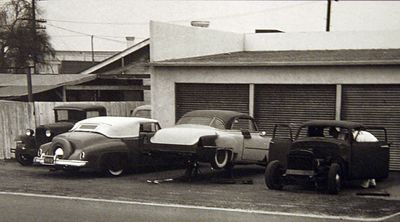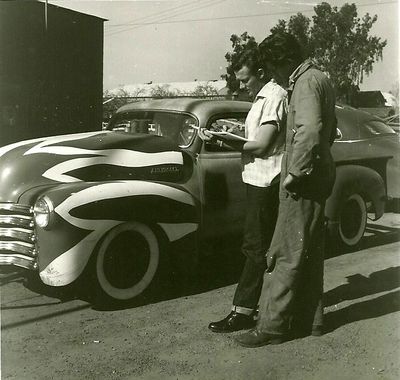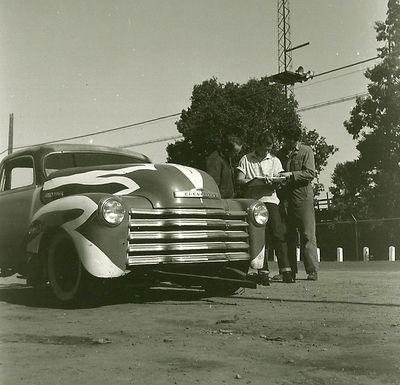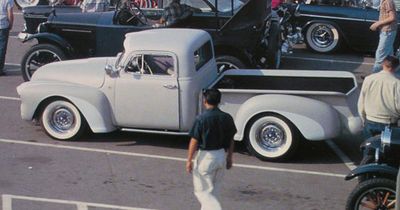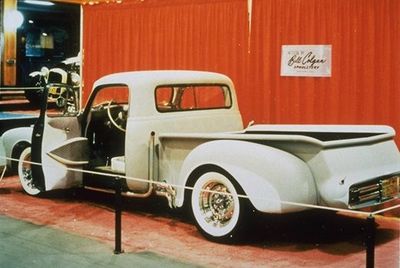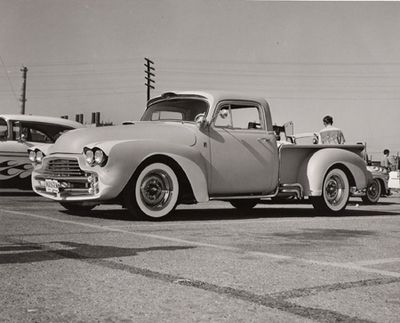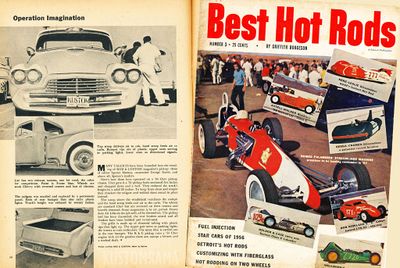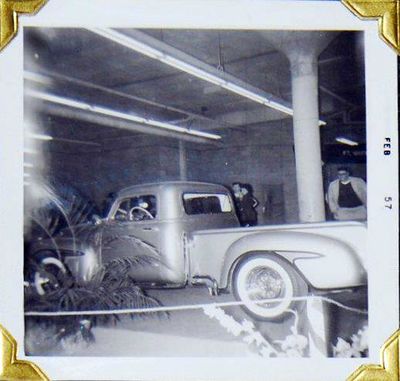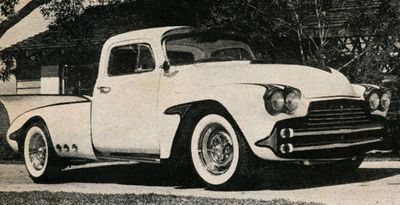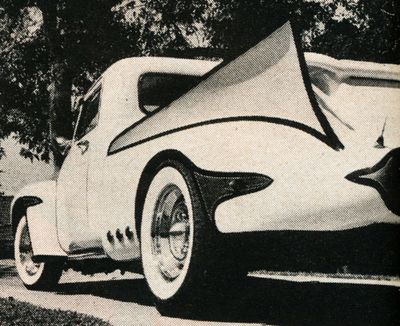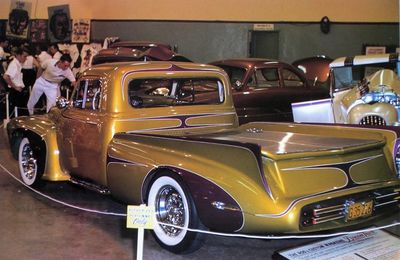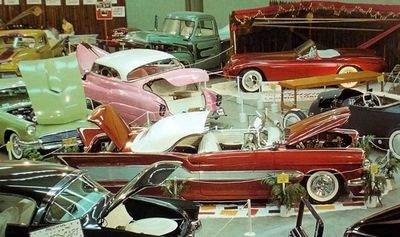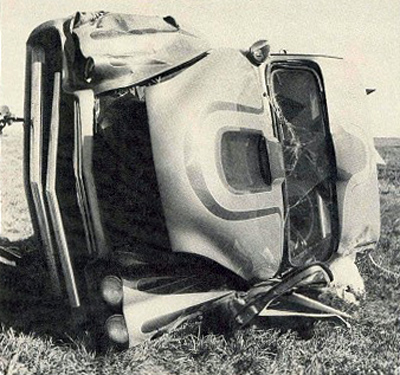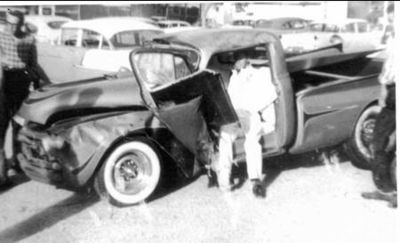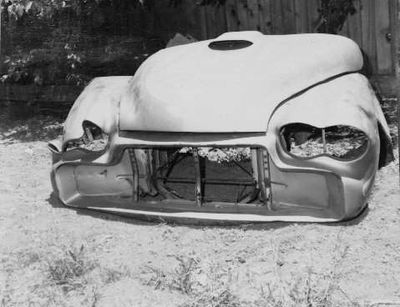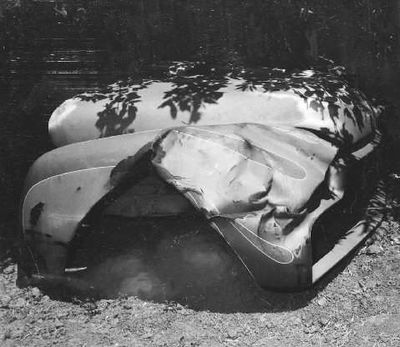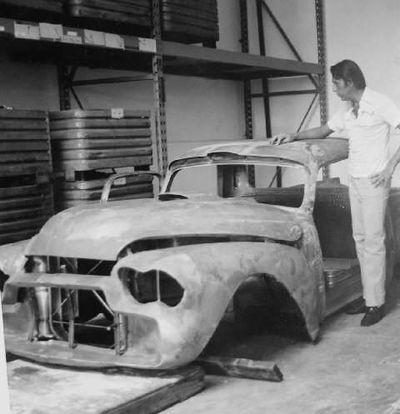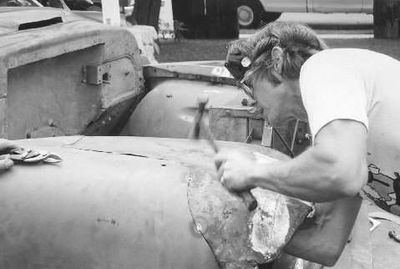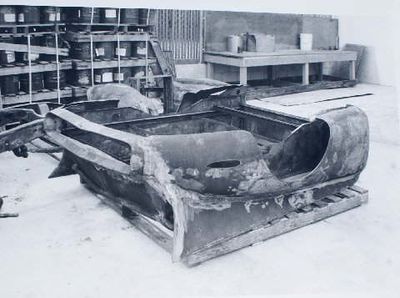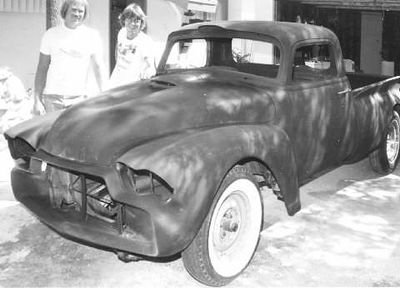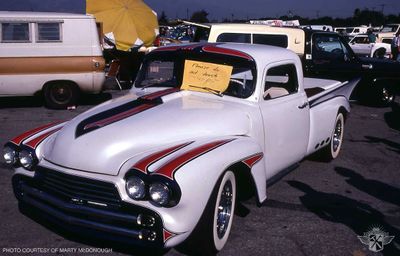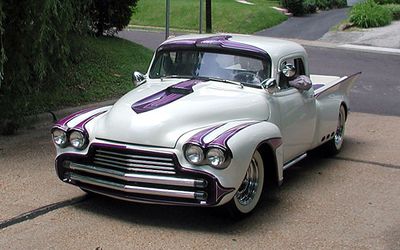Rod & Custom Magazine's Dream Truck
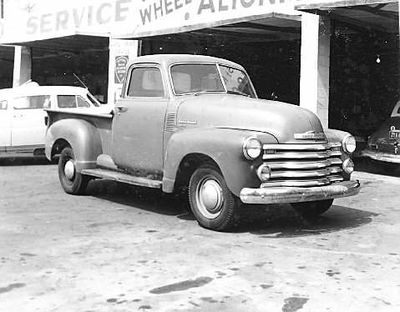


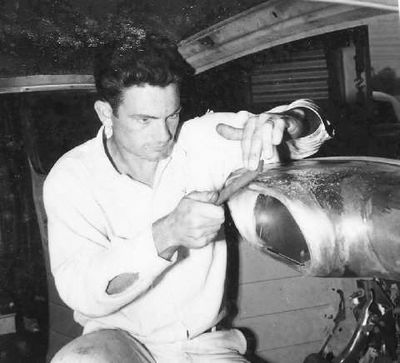
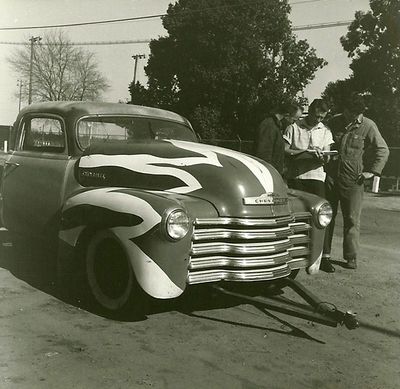

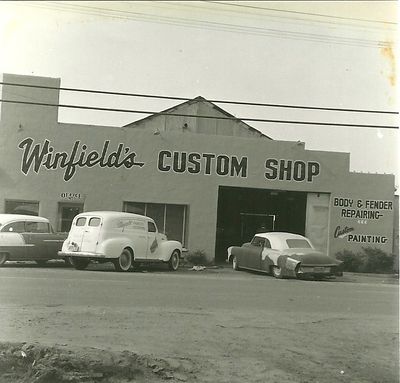

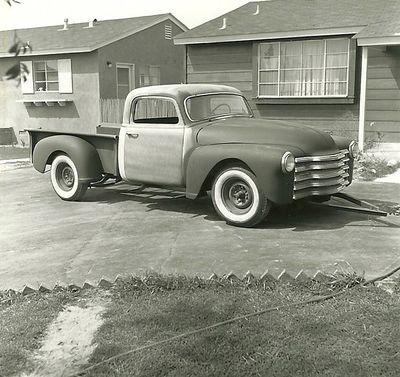
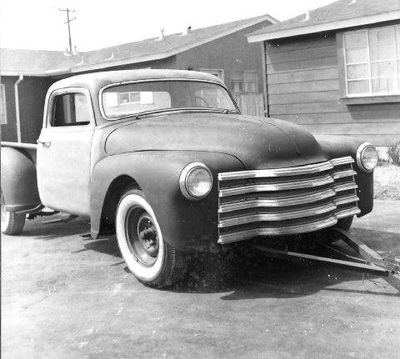


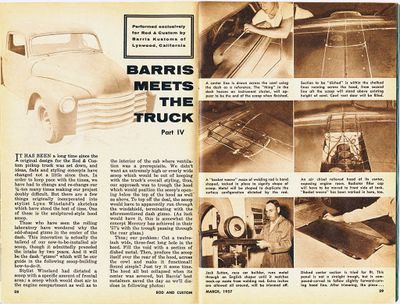
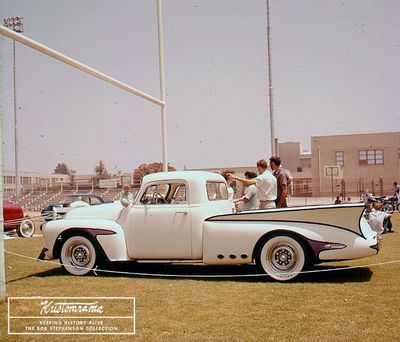
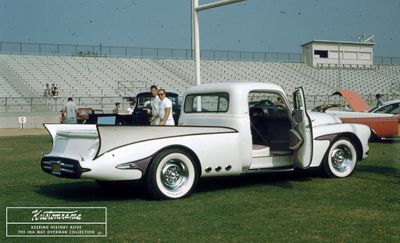
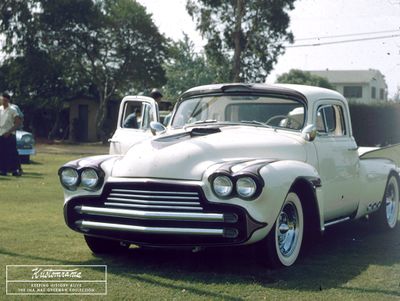

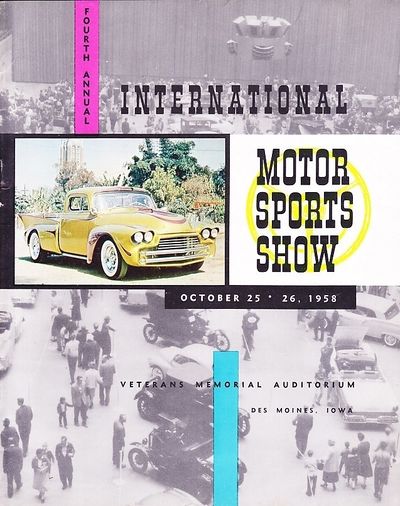

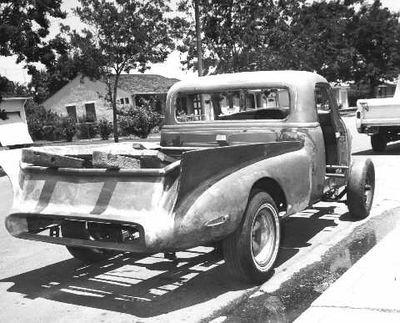
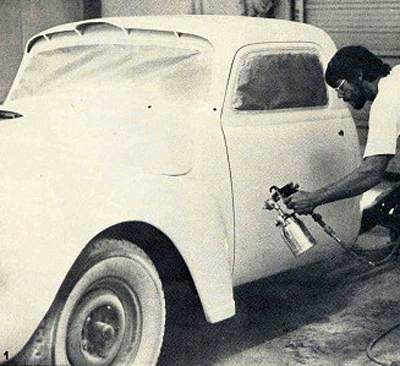
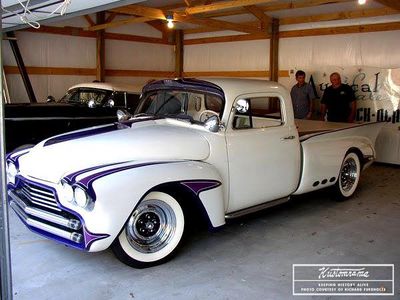

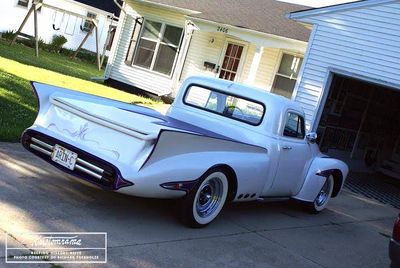

1950 Chevrolet 1/2 ton truck originally owned by Spencer Murray of Glendale, California. Spence bought the car after he went to work for Hop Up Magazine as he needed another set of wheels in addition to the Von Dutch striped 1954 Chevrolet hardtop that he and his wife shared. The car would eventually be known as "The Dream Truck"", and was designed by Lynn Wineland following suggestions from more than 2500 Rod & Custom magazine readers. It all started in Rod & Custom September 1953 where The Dream Truck was presented as a rolling labaratory that readers could help develop. [3]
In 1954 the Dream Truck was equipped with one of the first Chevrolet V8’s that left the factory. The engine was installed just before the 1954 Bonneville Nationals. After installing the engine, an before he hit off to the salt lakes, Spence sprayed white flames on the red truck. The car hadn't been customized yet, so it was still fairly stock. Spence did not run the truck on Bonneville, but used it for transportation so he could cover the event for the magazines. After returning from Bonneville the truck began its transformation as several California shops and builders customized it for Spence.[3] Sam Gates of Gates Auto Body in Pasadena chopped the top 3-3/8 inches and sectioned the body 5-1/3 inches. Neil Emory and Clay Jensen of Valley Custom in Burbank finished the chop and sectioning work, and hand-formed the beautiful dashboard. According to Spencer Murray, Neil Emory hammer welded the seams on the doors so painstakingly that the only lead required was at the doorjambs.[4] Curly Davis of Davis Custom Shop in Burbank finished the dashboard, integrated it into the door design, and widened the rear window.
After the cab was finished and the bed channeled Spence took the car to Gene Winfield of Winfield’s Custom Shop in Modesto.[5] Gene radiused the front-wheel cutouts and sectioned the hood, Barris Kustoms added quad headlights, scoops to the roof and hood, and front and rear grille openings formed by molding together 1957 Studebaker front pans.The front fenders were made from pieces of four Buick fenders, along with pieces from a stock Chevrolet. Bob Hirohata added the clear front and translucent red rear turn-signal lights. The first version of the Dream Truck was painted in gray primer with white scallops. In 1957 the car received a metallic lavender paint job with scallops applied by Dean Jeffries. The truck ran on stock chromed and reversed Chevrolet 15 inch wheels. Before buying the Dream Truck, Spence had owned several custom cars that Link Paola of Link's Custom Shop had restyled. Spence did also work for Link in his shop for a while. But before Spence bought the Dream Truck, Link had gone on to become an Oldsmobile dealer, and he had stopped doing customization jobs. Because of this, Link never did anything on the Dream Truck.[3]
After toruring the scene in its lavender version for a while, the Dream Truck was sent to Bob Metz of Shelbyville, Indiana for further restyling. Bob formed wild scratchbuilt canted fins and rear fenders for the truck. The fins were formed from quarter-sections of 1941 Buick turret tops.[4] After Bob Metz had fit the car with new rear fenders and fins, George Barris painted it bright white with scallops. This version of the car has also had parts of the exhaust pipes removed. This version of the car was later painted metallic lime gold with a fresh burgundy red scallop design. The lime gold version was painted by Larry Watson of Watson's House of Style. Each version was enjoyed by uncounted numbers of custom fans as Rod & Custom magazine campaigned the truck at car shows across the United States.
In 1958 The Dream Truck was nominated as one of 28 "Top Customs of the Year" in Motor Life July 1958.[6] Later on the same year, October 21 to be precise, on the way to the 4th annual international Motor Sports Show in Des Moines, Iowa, the Dream Truck was unfortunately wrecked. Spencer Murray was flat-towing the truck with a 1958 Chevrolet, and 15-20 miles shy of Pratt, Kansas the tow-truck blew the right rear tire. Murray let go of the gas and hit the brakes in the tow truck to slow down. The dream truck jack-knifed and went off the side of the road. Both trucks flipped over. The dream truck came of the tow bar, went up in the air, and came down on the right front fender, bounced again and came down on the left side with the left door open. The accident happened early in the morning. Luckily a motorist came by, and volunteered to go to Pratt and get a tow-truck to come back and help Murray. The tow-truck came, and they flipped both cars over on their wheels. Murray's tow-truck was still drivable although it was pretty beaten up and some glass had broken. The Dream Truck was towed into Pratt, while Murray drove the smashed up tow-truck. Arriving in Pratt, Murray called the show-promoter in Des Moines to tell him that the Dream Truck wouldn't be able to attend the show due to the accident. The show-promoter told Murray to bring the smashed up 1958 Chevrolet instead. Murray told him that the tow-truck wasn't a custom car at all, it had a paint job by Barris Kustoms, but that was about all. The promoter told them to come anyway, and promised them a trophy just for being there. Murray and his friend left the Dream Truck in Pratt, and attended the show in Des Moines with the smashed up tow-truck. They came back to Pratt a couple of days later, and found a semi-truck that was going to California with an empty trailer. Murray paid the truck-driver about $50 to drive the Dream Truck back home. In California, the truck was delivered at Barris Kustoms where George Barris took a look at it. The truck wasn't insured, and George told Spencer it would cost about $1,200 to fix it up and get it back in primer. This was too much for Murray, so he took it home and stripped it for undamaged parts such as the wheels and tires, engine, transmission, instrument, steering wheel and such parts. He sold the parts, and had only the damaged remains left. The remains were just sitting in the garage taking up space. Murray was sick of it and didn't know what to do with it. One day a neighbor kid stopped by and told Murray that he knew about someone that was interested in buying the remains. Murray told the kid that he wanted $100 for what was left of the truck. The kid came back with his friend. He looked at it and said he would take it. His only problem was that he only had $55. They worked out a deal, and the kid traded the $45 for labour on a boat Murray had lying in the harbor that needed some wood work. After working down his debts, the kid brought home the remains of the truck. He told Murray he would restore the car, so after a couple of months Murray called him to check out if he'd actually started on the truck. His mother answered the phone, and told Murray that he hadn't started on the truck, and that he was in the army. While the kid was in the army, the family moved, and Murray lost track of his old truck.[7] The family had moved to Stockton, California, and the kid's father had brought the truck with him and stored it in a barn. When the kid came out of the army he settled down, got married, and wasn't interested in the old smashed up truck. Nobody knew where the truck was at, and it would take 20 years until it surfaced again.
A freelance contributor spotted the remains of the truck one day as a guy was cleaning out of his garage and had pulled the truck out in the front yard. By then the truck had gone through a couple people since Murray sold it. The freelance-contributor took some pictures of the car and sent them to Murray wondering if it could be the Dream Truck. Murray recognized his old custom car and was amazed that the truck had survived. About the same time Bruce Glascock stopped by Spencer Murray telling him that he had to find the Dream Truck. Murray finally gave after, and told Glascock that he knew that the truck was somewhere in Stockton. He told Bruce that he didn't knew the address. Bruce went to Stockton, and went from door to door looking for the truck. He finally found the guy who owned the truck in 1971. Bruce asked the owner if he would sell the truck, but he refused to sell it as he had planned to fix it up. Glascock told him that he would give anything he wanted for the truck, but he still refused.[8] After begging the fellow for several years, the owner told Clascock in July of 1977 that if he had not started work on the truck by the end of the year he would sell it. On January 1, 1978 Glascock called the owner, and he agreed to sell it. Glascock called Gary Emory, and they left the next day to retrieve the remains.[9]
After picking up the remains, Glascock procured a bodyshop especially for the restoration of the car. After a while Glascock gave up his short-lived bodyshop investment, and returned to his regular profession of electrical contracting. After selling the shop he hired a skilled metalman to begin the restoration of the Dream Truck. The car was dismantled into bits and pieces, and the sheetmetal sent to Redi-Strip in Santa Fe Springs, California for stripping. After the parts returned from stripping, Glascock's skilled metalman "disappeared", and Bruce had to find a new suitable replacement. Not able to find anyone in California, Glascock hired Carl Green and Wesley Jones of Bartlesville, Oklahoma to do the job. When the parts were stripped for paint, bondo and filler, Green decided not to relead leaded parts of the car as this would melt the original lead away. Instead he decided to thoroughly clean both virgin sheet metal and lead with Prep-Sol, before he applied a thin skim coat of plastic filler. Doing this, he retained the original surface contours where they were unaffected by damage and help seal the antiquated surfaces against further deterioration.[4]
The original frame had been "diamond-shaped" in the accident, so a temporary frame was found on a junkyard and used as a jig. Before Carl could start on the bed, he had to cut of the fins Bob Metz grafted on to the car in order to prime under the side rails. As the whole body had been stripped, the underside would soon start to rust if they didn't prime under the side rails, and the only way to get access to this area was to remove the fins by cutting them of at their original seams. With this problem taken care of, Carl could go ahead and replace the rear fenders, and redo the seams where the rear of the fins joined the 1957 Studebaker grille pans that made up the rear grille cavity below the non-opening tailgate. The bed, who only had some surface dents, could firmly be bolted to the repaired frame. When the bed was mounted on the frame, Carl could use it as reference point from which all the other body parts would be aligned. Working forward, Carl could then mount the bed to the frame. The left side of the top, and windshield had been badly damaged in the crash, but the inner floor was luckily square and sound, and the body mounts aligned perfectly with the frame. Before tightening the body, Carl studied old photos of the car, making sure the gap between the body and bed was correct. The gap was critical as George Barris during the final face-lift on the car had modified the leading edges of Bob Metz' fins to bring them into very close proximity with the cab, subtly curving the knife edges to precisely follow the cab's contour. If this gap on either side had opened up, the uninterrupted visual flow on the cab and bed would have been lost. The left door on the car flew up during the roll over, and it had been jammed into the cowl, and bent double. A replacement door was located on a junkyard, and shipped to Redi-Strip. When the door returned Carl had to chop and section it in order to make it fit the car. By now Carl, and his partner Wesley realized that in order to complete the restoration they would need large portions of outer skins and structural parts. Frank Torre of A&A Auto Supply in Garden Grove, California had a 1953 GMC available that Carl bought as a donor car. The car was a project that someone had started and given up on, so the body was stripped for trim, sandblasted and red primered. The engine and transmission were gone, and the brakes and suspension were rebuilt. By using a full-size plan drawing made from the donor truck, the mangled left door opening was straightened using Porta-Power, jacks, slide-hammers, and torch. The front sheetmetal on the car was a mess. The first crunch during the rollover had been on the quad headlight area of the right front fender. Carl wanted to keep as much as possible of the original sheetmetal on the car, and cut away the non-fixable parts of the right front fender. The front portion of the original sheetmetal and the Barris Kustoms built opening was saved. The corresponding pieces of the front fenders were cut of the GMC fenders and ash-cannerd. The remains were carefully trimmed to match the cuts made in the original fender. Gene Winfield's radiused wheel openings were then duplicated on the new fenders. Carl and Wesley worked on a very short deadline. They had closed their Bartlesville shop for the trip west, and promised their customers that they would be back in 10 working days. The car had also already been scheduled into the 1979-1980 car show season, and the premier event was not far away. By the end of the 6th day, the heavy metalwork was conlcuded to everyone's satisfaction. The next couple of days were used to remove the light surface rust that had appeared after the Redi-Strip treatment. By the end of the eight day Carl and Wesley had completed their task, and could jump on a plane back home.[4] The original plan was to have Carl and Wesley bring the crashed car back into some semblance of the original shape, and then leave the detailing and get-it-running chores to people in the Los Angeles area. But owner Bruce Glascock was so impressed by their craftmanship and speed, that he decided to send the truck to Carl and Wesley's newly opened custom shop Wes and Carl's Custom Shop in Barlesville, Oklahoma for completion. Before the car was shipped to Barlesville it was fit with an engine and transmission, and other extra parts such as a 1956 Chevrolet Corvette steering wheel. Bon-A-Rue Upholstery in Irvine, California had taken the remains of the original upholstery to use as patterns, and stitched up a new interior for the car. These were not done in time for the shipping of the car, so the upholstery, along with wide-white tires from Cepek and an early Ofenhauser 3-pot intake manifold for the Chevy V8 were send separately. Jim's Upholstery in Bartlesville installed the brand new upholstery in the Dream truck. Jim's Upholstery did also fabricate a headliner and bed cover in matching materials for the truck. After the truck arrived in Carl and Wes' shop, they had three weks to complete the build. When the truck arrived the team started by getting chromed pieces ready for replating. All chrome pieces were sent to a "specialist" plater in Oklahoma City. When the parts returned, several pieces had been badly bent during the buffing process. One of the grille bars was buffed clear, and had to be replaced. The damaged parts were sent to a plating shop in Tulsa for a second try. In California Carl and Wes had only finished the bodywork roughly before coating it with a light dusting of primer. This had to be removed, before the final bodywork could take place. Carl, Wes and two after hour workers jumped on the bodywork, dinging out kinks and rough spots. The truck was then painted in a white plastic filler, followed by heavy cheese-grating and block-sanding. After that followed a round if careful panel alignment. When the surfaces were ready for paint, Carl shot several light coats of Chevrolet White as his underbase for the pearl white top coats. This was followed by Ditzler's Platinum Star white pearl lacquer. When it had set up, the car was wet-sanded using 600 paper and soapy water. After the sanding, scallops were masked on the car. The outlines were scaled up from original photos, and laid out on the newly painted truck. After nine hours of hard work the panels looked right, and Carl could begin to paint the panels in Ditzler's Burgundy and Purple Toner, just as George Barris had done 22 years earlier. The scallops were wet sanded, and covered with several coats of Ditzler clear lacquer, followed by a final light wet sanding and machine buffing. After painting the car, bits and pieces such as the 1953 Buick Super portholes and other trim could be mounted. When Bruce found the car, most of the parts were still with the car. One piece that missed though was the overhead console containing the gas, oil pressure, water temperature, and ammeter gauges. Since this was lost, Carl fabricated a new console from sheetmetal og light bar stock duplicating the piece from old photos.[10] After the restoration, the Dream Truck was placed on the Darryl Starbird Show Tour. After the initial restoration, Bruce re-did the entire car to make it roadworthy.
In 1986, Bruce sold the truck to custom car collector Kurt McCormick who rebuilt and modified the drivetrain and front suspension, then presented the truck again to the custom car world. After owning it for about 35 years, Kurt sold the car to custom car collector Tim McMann around 2022.
Contents
Rod & Custom Articles Covering the Build
Rod & Custom September 1953 - Building a Chevmobile (Installing Oldsmobile engine)
Rod & Custom May 1954 - Top Chopping - The Right Way (Pt.I)
Rod & Custom June 1954 - Top Chopping - The Right Way (Pt.II)
Rod & Custom July 1954 - Frame Arching
Rod & Custom August 1954 - How To Build a Custom Dashboard
Rod & Custom August 1954 - Floor Shift For Automatic Transmissions
Rod & Custom September 1954 - Sectioning The Pickup (Pt.I)
Rod & Custom October 1954 - Sectioning The Pickup (Pt.II)
Rod & Custom July 1955 - Down With The Pickup
Rod & Custom August 1955 - Fix Up Your Pickup
Rod & Custom September 1955 - The New Huth Twin (Muffler Installation)
Rod & Custom October 1955 - Out With The Old - In With The New (Pt.I)
Rod & Custom November 1955 - Out With The Old - In With The New (Pt.II)
Rod & Custom November 1955 - Long Winding Gears For The Chevrolet
Rod & Custom March 1956 - Progress Report (window glass)
Rod & Custom April 1956 - Operation Teardown
Rod & Custom May 1956 - Pickup Progress (lowering and channeling)
Rod & Custom June 1956 - Trouble With Heads
Rod & Custom June 1956 - Open Wheel Wells
Rod & Custom July 1956 - Hood Sectioning
Rod & Custom October 1956 - Throttle Linkage
Rod & Custom December 1956 - Barris Meets The Truck (Grille Shell Pt. I)
Rod & Custom January 1957 - Barris Meets The Truck (Grille Shell Pt. II)
Rod & Custom February 1957 - Barris Meets The Truck (quads)
Rod & Custom March 1957 - Barris Meets The Truck (Hood air scoop)
Rod & Custom April 1957 - Barris Meets The Truck (Grille installation)
Contributors On the Dream Truck
Gates Auto Body, Pasadena - Top chopping
Valley Custom, Burbank - Body sectioning and dash construction.
Davis Custom Shop, Burbank - Metal refinishing and window enlarging.
Winfield’s Custom Shop, Modesto - Wheel well radiusing and hood sectioning.
Barris Kustoms, Lynwood - Grille and bed work, headlights, air scoops, upper dash and 3-tone paint.
Bob Metz, Shelbyville - Fins and rear fenders.
Weber Tool Company, Los Angeles - Engine flywheel, roller cam, block work.
Geraghty Automotive, Eagle Rock - Engine boring, parting and assembly.
Moon Automotive, Santa Fe Springs - Throttle and carburetion, final engine tuneup.
Offenhauser Equipment Company, Los Angeles - Rocker arm covers and manifold.
Hedman Heddders, Los Angeles - Exhaust headers.
Huth Muffler Company, Burbank - Complete 6-way exhaust system
Cragar Equipment Company, Bell - Dropped axle, transmission gears, instruments.
Harry's Wheel & Brake, La Cresenta - Front and rear suspension, engine installation.
Colgan Auto Upholstery, Burbank - Upholstery and bed cover.
Pico Rim & Wheel, Los Angeles - Wheel reversing.
California Plating Company, Los Angeles - Chrome plating.
Priester Chevrolet, Montrose - Aquisition of chassis and body parts.
Eastern Auto Supply, Los Angeles - Hubcaps, aerials, countless parts.
Lynn Wineland, Rod & Custom - Original design incorporating readers ideas.
Magazine Features
Rod & Custom September 1953
Rod & Custom May 1954
Rod & Custom June 1954
Rod & Custom July 1954
Rod & Custom August 1954
Rod & Custom August 1954
Rod & Custom September 1954
Rod & Custom October 1954
Rod & Custom July 1955
Rod & Custom August 1955
Rod & Custom September 1955
Rod & Custom October 1955
Rod & Custom November 1955
Rod & Custom November 1955
Rod & Custom March 1956
Rod & Custom April 1956
Rod & Custom May 1956
Rod & Custom June 1956
Rod & Custom June 1956
Rod & Custom July 1956
Rod & Custom October 1956
Rod & Custom December 1956
Rod & Custom January 1957
Rod & Custom February 1957
Rod & Custom March 1957
Rod & Custom April 1957
Custom Cars September 1957
Rod & Custom September 1957
Best Hot Rods Number 3
Trend Book 156 Custom Cars 1958 Annual
Rod & Custom April 1958
Rod & Custom May 1958
Motor Life July 1958
Custom Cars October 1958
Rod & Custom January 1959
Car Craft February 1959
Rod & Custom August 1990
References
- ↑ 1.0 1.1 1.2 Rik Hoving Custom Car Photo Archive
- ↑ 2.0 2.1 2.2 2.3 2.4 2.5 2.6 2.7 Hotrod Hotline - Blast to the Past
- ↑ 3.0 3.1 3.2 Spence Murray
- ↑ 4.0 4.1 4.2 4.3 The R&C Dream Truck Saga II
- ↑ Spencer Murray
- ↑ Motor Life July 1958
- ↑ Legends of the Rod & Custom Hall of Fame - THE ROD & CUSTOM DREAM TRUCK SAGA, PT.1
- ↑ Legends of the Rod & Custom Hall of Fame - THE ROD & CUSTOM DREAM TRUCK SAGA, PT. 2
- ↑ Bruce Glascock
- ↑ The R&C Dream Truck Saga III
Sources
Rod & Custom July 1957
Rod & Custom February 1959
Classic Customs and Lead Sleds by Bo Bertilsson
Rod & Custom Magazine
HowStuffWorks Dream Truck Custom Car
Did you enjoy this article?
Kustomrama is an encyclopedia dedicated to preserve, share and protect traditional hot rod and custom car history from all over the world.
- Help us keep history alive. For as little as 2.99 USD a month you can become a monthly supporter. Click here to learn more.
- Subscribe to our free newsletter and receive regular updates and stories from Kustomrama.
- Do you know someone who would enjoy this article? Click here to forward it.
Can you help us make this article better?
Please get in touch with us at mail@kustomrama.com if you have additional information or photos to share about Rod & Custom Magazine's Dream Truck.
This article was made possible by:
SunTec Auto Glass - Auto Glass Services on Vintage and Classic Cars
Finding a replacement windshield, back or side glass can be a difficult task when restoring your vintage or custom classic car. It doesn't have to be though now with auto glass specialist companies like www.suntecautoglass.com. They can source OEM or OEM-equivalent glass for older makes/models; which will ensure a proper fit every time. Check them out for more details!
Do you want to see your company here? Click here for more info about how you can advertise your business on Kustomrama.
